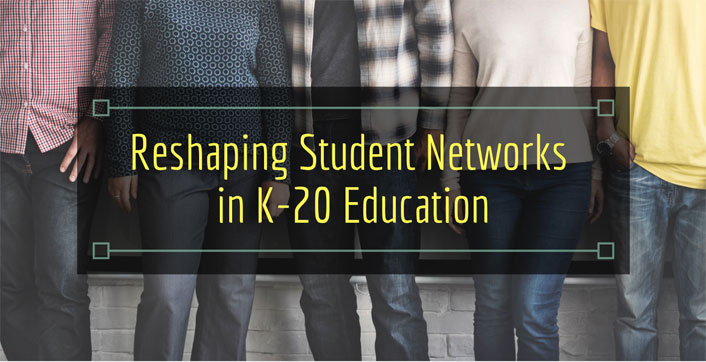
Other Posts in this Series
Oftentimes education reformers try their best to imagine how a coherent, high-quality K-20 system could arm more students with the skills, knowledge, and dispositions to succeed in the 21st century. We debate which institutions, standards, tests, cost structures, and pedagogies can support learning to new heights. We measure so-called 'college and career readiness' in terms of grades, academic mastery, and habits of success. We celebrate innovations that move the needle on those fronts.
These are all valiant and necessary efforts. But there are other ingredients to success besides learning. Something else is accumulating over those years of a student's formal education that few reform efforts have tried to tackle: that student's network. Historically, a student's network was left up to chance, treated as a mere byproduct of the schools that he or she did or didn't attend. Only later, down the line, did we find ourselves urging young adults to build half-baked LinkedIn profiles and go out to 'network' to find a job.
That is, until now. Innovations across K-12 and higher education are beginning to open up new channels to strengthen students' access to relationships. And as these technology tools begin to expand the diverse array of experts, mentors, coaches, and even prospective employers at students' disposal, they are upending limitations of students' inherited networks and helping our institutions of learning evolve to simultaneously serve as institutions of connecting.
Early Connections
These efforts can start early. In K-12 schools, the age-old 'bring your parent to school' day is getting a major update. Tools like Nepris, a platform that beams industry professionals into classrooms virtually to bring real-world context to curricula, are allowing students to learn from real-world experts at the press of a button. These brief connections can at once furnish students with a sense of academic relevance while also allowing students to engage in live interactions with an adult from an industry to which they may otherwise have few ties.
Online connections don't merely focus on particular industries or academics. For example, online mentorship models allow adults to support students in a wide variety of areas. Tools like iCouldBe offer online mentoring that brings virtual volunteer professionals into schools serving at-risk middle and high school students. Through partnerships with large employers like AT&T, iCouldBe offers online mentors who can guide students through an 81-activity curriculum designed to support their academic success, postsecondary educational planning, and career planning.
College-Going Supports
Innovations in connecting are likewise penetrating the formal college counseling space. A staggering 94 percent of states fall below the recommended ratio of 250 students for every college guidance counselor. In many schools, counselors find themselves stretched thin as they address the litany of non-academic factors that shape student outcomes. Enter organizations like Student Success Agency (SSA), which connects high school students to their own personal online 'agent' who helps guide them through the college application process. SSA's agents consist of current college students recruited from around the country.
Tech-enabled tools are also helping students to more smoothly transition through college. For example, Beyond12 supports low-income students in college, offering near-peer coaching — both face-to-face and online — as well as access to on-demand experts who can help students successfully make it to graduation.
Expanding Career Options
For older students trying to break into the workforce, new providers are linking student-learning activities with employer projects. For example, Knod [http://www.knod.net/], a project-based learning platform that sources projects directly from connected employers, allows students to engage in projects to learn and demonstrate new content and skills, in tight connection with industry professionals—and prospective employers—with whom they can build rapport along the way.
Other tools explicitly help students and institutions to organize and build their networks to ease their transition from college to career. For example, one of Reach Capital's latest investments, PeopleGrove, is a platform that leverages an organization's trusted network of professionals, wealth of social capital, and sense of affinity to help students and young professionals access on-demand advising, mentoring, and coaching. The tool even provides students with scaffolded supports that help students use appropriate style and syntax when reaching out to new professional connections or prospective mentors.
What do all such efforts have in common? First, by using technology to support connections, these tools defy the geographic and socioeconomic boundaries that historically circumscribed students' networks. Second, these tools stand to diversify the range of supports at students' disposal beyond the peers, teachers, or professors that students might encounter in a given day at a traditional institution. Third, all of these tools are effectively leveraging human relationships to forge stronger connections between the world of school and the world of work—a separation that historically proved difficult for both K-12 and higher education to bridge.
In efforts to improve academic outcomes, we sometimes forget that opportunity is a social endeavor. As the field races to discover and scale innovations in learning, we shouldn't forget about the parallel innovations shaping the other half of the opportunity equation: innovations in connecting.
Julia Freeland Fisher is director of education for the Clayton Christensen Institute.
